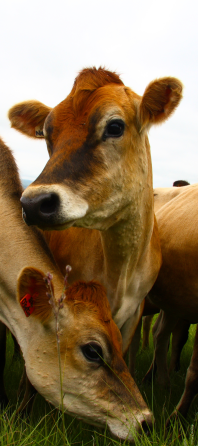
Management Guidelines
Dry Matter Intake

Dry matter intake (DMI) of the transition cow and its effect on future performance continues to be an area of active research. The challenge lies in the fact that as the cow approaches calving, DMI decreases significantly while the nutrient requirements of the foetus increases rapidly, causing the cow to go into negative energy balance. For optimal cow performance, it is recommended that the intake of a properly balanced dry cow ration be maximized, and the decrease in intake prior to calving be minimized. DMI during the close up dry period is closely related to DMI in the subsequent lactation. Minimizing the decrease in DMI pre-calving also decreases the cow's susceptibility to ketosis and fatty liver.
The following guidelines should be followed to optimize dry matter intake:
- Feed a properly balanced ration
- Offer fresh feed daily to close-up dry cows
- Provide a clean, dry, uncrowded environment
- Minimum 150 ft2/cow in bedded pack/pen
- Maximum free stall capacity of 80%
- Provide clean mangers and adequate bunk space
- >2 feet manger space/row
- Ensure cows have access to free-choice water
-
Minimize cow movement pre-calving.
Body Condition Scoring/ Energy Balance
Maintaining the proper body condition score during the dry period is imperative in preventing various post-calving metabolic disorders such as ketosis and fatty liver disease. Insufficient intake of energy, either due to lack of DMI, or a poorly balanced ration, will cause the dry cow to begin using her fat stores and increase fat deposits in the liver. On the other hand, a diet containing excess energy also leads to greater fat deposits in the liver, and may also negatively impact DMI as body condition score increases.
Recent research has suggested that the body condition score for dry cows at the time of dry off should fall in the range of 3.0 to 3.75, and that it should not change throughout the dry period.
Length of Dry Period
Much attention recently has been focused on shortening the dry period from 60 days down to 30-45 days. Research in this area has made the following observations
- Shorter dry periods can work well with multiparous cows (2+ lactations), heifers do not respond well
- A shortened dry cow period requires excellent management to monitor intakes and body condition score
- May be beneficial for over-conditioned cows
- Dry periods less than 30 days tend to be less successful
- SCC tends to be higher in some herds with shortened dry cow periods.
For producers who lack facilities to divide dry cows into far-off and close-up groups, a shortened dry period may be an option worth exploring. The more traditional dry cow program of 8 weeks (5 weeks far-off and 3 weeks close-up) continues to be followed successfully on many dairy farms. Discuss your options with our Purina Farm Consultant to determine which program best suits your operation and goals.
Heat Stress
Dry cows especially close up dry cows are very susceptible to heat stress. Research has shown that dry cows that are cooled produce more milk in their subsequent lactation.
Lighting
The optimal lighting strategy for dry cows is 16 hours of darkness and 8 hours of light (the opposite of what is recommended for lactating cows). Studies have shown that under this lighting regime, cows gave on average 3 kg more milk/day (Miller et al, Journal of Dairy Science, 2001)